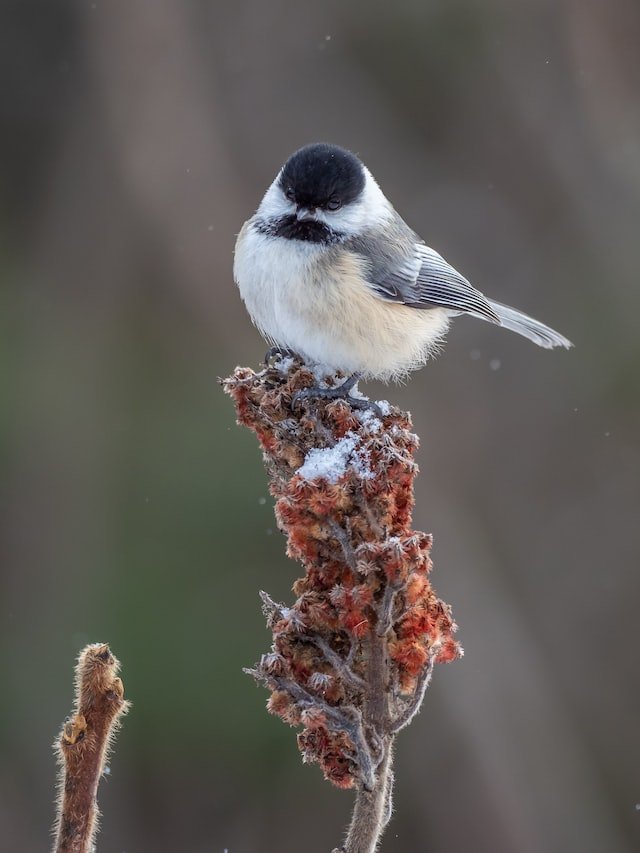Updated: February 6, 2024
Did you know that Black-capped Chickadees are already singing for a mate?! Their first songs can be heard around the second week of January, each and every year - like clockwork.
This behavior is triggered by the the most powerful stimulus for plants and animals: photoperiod (the period of light during each day).
We’ve gained about 45 minutes of daylight since Winter Solstice and these cheerful little birds are deeply attuned, responding in song as they take their first devoted steps toward bringing more of their kind into the world.
Their songs signal me to celebrate - that we’ve made it through our darkest days. We don’t need to wait until March. As early as mid-January, these chickadee songsters are the true harbingers of spring in this part of the world. We just need to listen.
Different than the "chickadee-dee-dee” call, their song is a simple pure whistle of two or three notes that sounds a bit like "hey sweetie" or " fee bee". Take a listen here (source: Cornell Lab of Ornithology).
A bird’s call and a bird’s song communicate very different things, and if you’re a chickadee you use at least 16 different vocalizations. Chickadees might not be the first species that comes to mind when you think of bird intelligence, but these little birds have developed a remarkably complex and sophisticated language. Their calls and songs communicate varying levels of danger, details about threats to the flock, courtship opportunities and ranking of males, territorial information, and real-time intel on food resources. Incredible, isn’t it?!
Want to learn more? You can learn how to de-code some of their impressive repertoire with the help of Lesley the Bird Nerd’s You Tube channel here.
Not only do chickadees garner my admiration for their intellect and resourcefulness, but they quite literally embody the first notes of spring. When I hear their sweet songs on a sunny winter day it fills my cup with the promise of growing light and green shoots. Their songs are one of my all-time favorite seasonal sounds.
Their clear two-note whistles evoke so many memories and feelings for me, bringing me back to days of long snowshoe treks to bear dens. Those were the days!!
Did you know…? The winter-persistent fruits of our native Staghorn Sumac (Rhus typhina; pictured here) are consumed by Black-capped Chickadees and at least 20 additional bird species.
Black-capped Chickadee perched on Staghorn Sumac (Rhus typhina). Photos by Patrice Bouchard.
I hope you enjoyed this Phenology Note!
Join me in witnessing the seasons of our wild world.
Posted regularly here, and on Facebook and Instagram:
Follow #ThePersonalEcologist & #PhenologyNotes
SIGN UP TO RECEIVE free tips, tools, and insights for building habitat and hope.
#ThePersonalEcologist
I co-create biodiverse habitats with eco-minded stewards throughout the Northeast - at any scale.
I have 30 years of experience and a lifelong commitment to wildlife conservation.
Read My Story.
-
Deborah
Perkins
- Jan 8, 2026 Carnivore Coexistence (Leopold's Wise Words - Part 1)
- Oct 31, 2025 Hallowed Habitat
- Dec 22, 2023 Storm Habitat: Nurse Logs, Dens, and More
- Aug 8, 2023 Beautiful Buttonbush in Bloom
- Jun 17, 2023 Snapping Turtles on the Move
- Feb 1, 2023 The True Harbingers of Spring: Chickadees
- Mar 20, 2021 The Power of Photoperiod
- Feb 19, 2021 The Golden-crowned Kinglet: A Royally Charming Winter Resident
- Feb 8, 2021 Subnivean Secrets
- Jan 9, 2021 Wild Reads: Ravens in Winter
- Oct 23, 2020 Flower “Beds” for Bumble Bees
- Oct 4, 2020 Wise Oaks, Clever Jays
- Sep 11, 2020 Goldenrods: Top Plants for Boosting Biodiversity
- Aug 25, 2020 Gentle Golden Wasps Adorned with Pollen
- Aug 1, 2020 Water for Wildlife - Birdbath Basics & More
- Jul 19, 2020 Fruits of the Forest
- Jul 11, 2020 Hungry Little Hummingbirds
- Jun 24, 2020 Hatching Out: Mother Nature's "Escape Room"
- Jun 12, 2020 Maine's Real Lupine Revealed
- May 31, 2020 Wild Geranium in Flower
- May 24, 2020 Moosewood Chandeliers
- May 17, 2020 Shadbush in Bloom
- May 7, 2020 Native Nectar for Queen Bumble Bees
- Apr 25, 2020 Waves of Warblers
- Apr 19, 2020 Attracting Bluebirds without Boxes
- Apr 12, 2020 Hungry Bears on the Move
- Apr 5, 2020 Bees on Red Maple Flowers
- Mar 27, 2020 Sky Dancing
- Mar 22, 2020 Fox Kits Being Born
- Mar 15, 2020 Corvids a-Courtin’
- Mar 8, 2020 Phenology Notes: Witnessing The Seasons of our Wild World
- Feb 5, 2019 Plan Your Habitat Garden
- Jan 2, 2019 Wild Reads: We Took to The Woods
- Nov 28, 2018 Winterberry: The Gift that Keeps on Giving
- Aug 16, 2018 Where Have All the Whip-poor-wills Gone?
- Jun 22, 2018 Give a Warm Welcome to Wild Bees (Super-pollinators Part 2)
- May 16, 2018 The Wonder of Wild Bees (Super-pollinators Part 1)
- Apr 19, 2018 Saving Songbirds Starts with Your Morning Coffee
- Mar 21, 2018 Wildlife Habitat Design in A Wounded World
- Feb 16, 2018 “Intelligent Tinkering” - How to Boost Biodiversity at Home (Leopold’s Wise Words Part 2)
- Dec 14, 2017 Dead and Dying Trees are Key to Life
- Nov 14, 2017 A Top Threat to Biodiversity: Invasive Plants
- Sep 21, 2017 Beechnuts - Superfood for Bears & Other Wildlife
- Aug 22, 2017 Baby Bats Need Love Too
- Jul 25, 2017 Bring the Magic of Fireflies Back Home Again







